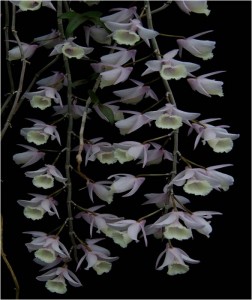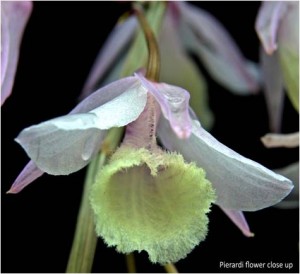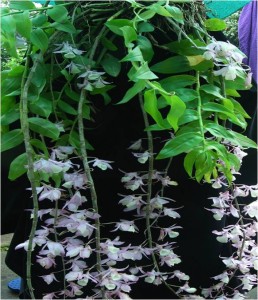Dendrobium aphyllum (Roxb.) C.E.C.Fisch
Article by: Suresh Kalyanpur
Introduction: Dendrobium pierardii or aphyllum or cucullatum is an orchid found in most collections. It is also known as the ‘hooded orchid’ because of the cone shaped lip of the flower. It is attractive and easily cultivated and has long, pendulous stems that become leafless in the resting period and, for a few weeks during the spring. It carries numerous, pinkish violet, fragrant flowers with a pale yellow or whitish lip. Although there are many prettier species in the Dendrobium genera, few are as rewarding and persistent as the pierardii in cultivation. The species was discovered by William Roxburgh in southern India and described in his book Plants of the Coast of Coromandel in 1795. During most of the nineteenth and twentieth centuries, Dendrobium aphyllum was best known as D. pierardi, perhaps because the latter had been much better illustrated by Sir William Hooker in 1822. Under this name, it became one of the most widely cultivated Dendrobium species, a status that it still enjoys. Another name for this species, D. cucullatum, which was published in 1821 by Robert Brown, but until recently this had been almost forgotten. The correct name, D. aphyllum, only came into general use after 1985, when the influential Danish botanist Gunnar Seidenfaden confirmed, albeit with some reservations, that this was the same species that people were growing as D. pierardii. Gradually, the name D. aphyllum has come back into use and is the accepted name.
Distribution: From southern, central and north-eastern India, through Nepal, Bhutan, Burma, China, Thailand, Laos, Cambodia and Vietnam to Peninsular Malaysia, the Dendrobium pierardii grows in forests at 100–1,600 m and also on limestone cliffs.
Plant: Plant is an epiphytic orchid and sometimes lithophytic with clustered, cane-like, overhanging to pendulous stems of 20–200 cm long. The leaves are 3–10 cm long, 1–3 cm wide and deciduous after one growing season. These heavy long cane like stems assume the role of pseudobulbs. The canes are deciduous and the plant produces numerous aerial growths (keikis). The inflorescences are short, arising laterally from the leafless stems of the previous growing season. There are usually many inflorescences per plant, with one to three flowers on each. The flowers are 4–5 cm across and open widely with a pleasant fragrance. The sepals and petals are somewhat translucent, yellowish cream to whitish, more or less strongly suffused and marked with pinkish violet. The lip is trumpet-shaped, variable in width (from 2.0–3.7 cm wide when spread), pale yellow or less often white, whitish at the base, with dark violet branching veins inside the tube-shaped part, and densely covered with soft, short hair on the exterior surface and along the margins, except in the basal part. The flowers are flimsy and short lived, lasting about a week. These are borne on the previous year’s growth
Culture & Care: This terrific plant grows with a pendant habit, the growths first growing up, and then bending over and down. With light lavender blooms in creme colored lip, and fragrant, the plant is relatively easy to cultivate and make them bloom.
Light: While actively growing, provide the plants with plenty of bright but filtered light. They will grow well under the same light conditions as most Cattleyas. Most of these Dendrobiums grow attached to deciduous trees, so they want higher light in winter. Grow them under Cattleya light levels during the growing season, and move them to much brighter Vanda light levels during their resting period.
Temperature: In their natural habitat, these orchids experience mild to warm daytime temperatures in spring and summer, and generally cooler temperatures in the winter. For most, the winter night temperatures range from about 5°C to about 12°C. The temps are intermediate to warm in the growing season and the plants will do equally well with high temps in the 35’s.
Water: This may be the most crucial element to success with these orchids. In their natural conditions it is fairly wet during the late spring, summer and early fall. Rainfall is quite heavy for a few months, but it tapers off in the late fall, and the winter months are fairly dry. Water the plants regularly when they are actively growing. Mounted plants can be watered daily if air circulation is good. During the growing season, when the new leafy stems emerge and mature, the plant must be kept well watered in a humid atmosphere.
Nutrition: These Dendrobiums benefit from regular feeding when they’re actively growing. Any balanced, water-soluble fertilizer can be used, diluted according to package directions. The standard NPK 20-20-20 is a good option; feed once a week during the growing season. Reduce feeding in the fall and eliminate it completely when the plants are resting in the winter. Resume feeding after the flowers have finished. High Phosphorus and Potash during flowering and after maturity of bulbs is recommended.
Potting: The pendent stems of these orchids make them a challenge to grow in pots, so they are usually grown mounted, or in hanging baskets. The larger species can grow to great size, so if mounted, the mount material should be sturdy – a cork slab or dense tree fern plaque works well. Mounted plants can be watered daily in summer if the air circulation is good. In a basket, use a very well-drained epiphyte mix. However, mounting or growing in baskets is preferred. The species can be grown in pots with a medium of coco chips, charcoal and brick pieces, though they are likely do better mounted if possible.
Generally from May to October, regular, low doses of fertilizer (appropriate for epiphytic orchids) can be given. In late autumn and winter, heavy watering and fertilization should be stopped, although light misting can be continued to prevent too much drying out. The leaves will turn yellow and fall off. Lower temperatures (but not frost) and strong light during the leafless stage may stimulate flowering the following spring. Any open, well drained orchid compost will do, as long as waterlogged conditions are avoided.
Resting Period and care: Giving your Dendrobium a rest period can make a difference between a specimen plant with impressive and abundant flowers and one that is producing just a few blooms. Some of the species of Dendrobiums of this group are, anosmum, primulinum, aphyllum, nobile and parishii. This rest period simulates the conditions that triggers blooming in their natural habitats. The winter rest is absolutely necessary for spring blooming, and those that feel sorry for their plants and water or feed during the winter will be disappointed. Stop watering around the beginning of December and don’t resume until the buds have fully formed in the Spring.
 Observe the tips of the canes; in the fall, they will stop producing new leaves. This is the signal that the plant has finished growing for the season; gradually reduce watering, and allow the plant to dry somewhat between watering. There’s some moisture in the habitat at this time, so the plants do get a little water from dew or fog; a light watering every few days is all they need. Growth will start again in the early spring at about the same time that the flower buds begin to form. Once the buds have been formed, and new growth appears, increase watering again. It is quite typical for these Dendrobiums to drop all or most of their leaves during their winter resting period. Flower buds will appear on the stem opposite the attachment points of the leaves, and new growth will commence from the base of the previous year’s growth
Observe the tips of the canes; in the fall, they will stop producing new leaves. This is the signal that the plant has finished growing for the season; gradually reduce watering, and allow the plant to dry somewhat between watering. There’s some moisture in the habitat at this time, so the plants do get a little water from dew or fog; a light watering every few days is all they need. Growth will start again in the early spring at about the same time that the flower buds begin to form. Once the buds have been formed, and new growth appears, increase watering again. It is quite typical for these Dendrobiums to drop all or most of their leaves during their winter resting period. Flower buds will appear on the stem opposite the attachment points of the leaves, and new growth will commence from the base of the previous year’s growth
If, in the spring, the plants produce keikis (baby plants) on the stem instead of flowers, the plant is telling you that something in its environment is not correct. This may be too much water during resting; the plants need a little watering during this time but they must dry completely for two or three days between watering. It may also be due to problem with temperature.
References:
1. Dendrobium aphyllum – Species profile from Kew – www.kew.org/plants-fungi/Dendrobium-aphyllum.htm

Excellent review and a very scholarlypresentation !!
An excellent article. One can get to know anything and everything about Den. Pierardii culture n care from it. Extra ordinarily it can be helpful for any orchid grower regardless of the country he or she is living in.
Unfortunately we people here try to gather information about orchid care n problems from AOS and other reputed institutes abroad– many a time which leave us in more problems and helpless bewilderment as our climet might be extremely different from theirs. Especially at their guidelines about light (eastern or southern etc.) and water requirements of orchids. However, as far as I can make it out, this article is beyond these sorts of limitations. It’s great!👍
Thank you Mr. Kalyanpur and thanks to The Orchid Society of Karnataka.
Great … excellent information and very informative…..
Great work sir
Thanks so much ..extremely informative
To save Orchids and to save earth we need people like you all….
Great work and great research…
I wish you all to put little light on the fall of stems and changing colours of the stems and leaves .. Hope you will guide us more..
Extremely informative article..
Best wishes
Nagyon értékes és érthető tanulmány,köszönöm szépen
Thank you so much for nice write up. This one is common in in Bangladesh. So, please include Bangladesh in the ”Distribution” segment.
Thank you!
How to use 20 20 20? Please help me with water ratio
Apart from the resting period, ie between November and February, use the NPK fertiliser 20:20:20 in very weak dosage fortnightly say 2 grams to a litre. During the winter resting period stop all fertilisers and water, simply spray the canes once a weak.
What would it be the ideal winter rest temperature? Thanks for this great article!
In the natural habitat where it grows the temperature may be much lower than we can provide in places like Bangalore or Mysore. So it doesn’t really matter. Hence irrespective of the temperature your surroundings offer if you follow the suggested drill during the rest period, once the months of Feb/March come the plant comes back to life and start throwing out beautiful inflorescence.
I have also observed that after a year or two the plant will get acclimatised to your surroundings and slowly start flourishing in our warmer climates. Another suggestion during the rains, expose the plant to the purest form of water from the skies and see what a difference it makes.
Thank you very much for this article. It is very helpful. I have recently purchased a small plant that gave me several lovely flowers last month (November). I live in sub-tropical Queensland where there isn’t much of a winter so any hints regarding when I withhold water would be welcome. Also, when is the best time to repot please.